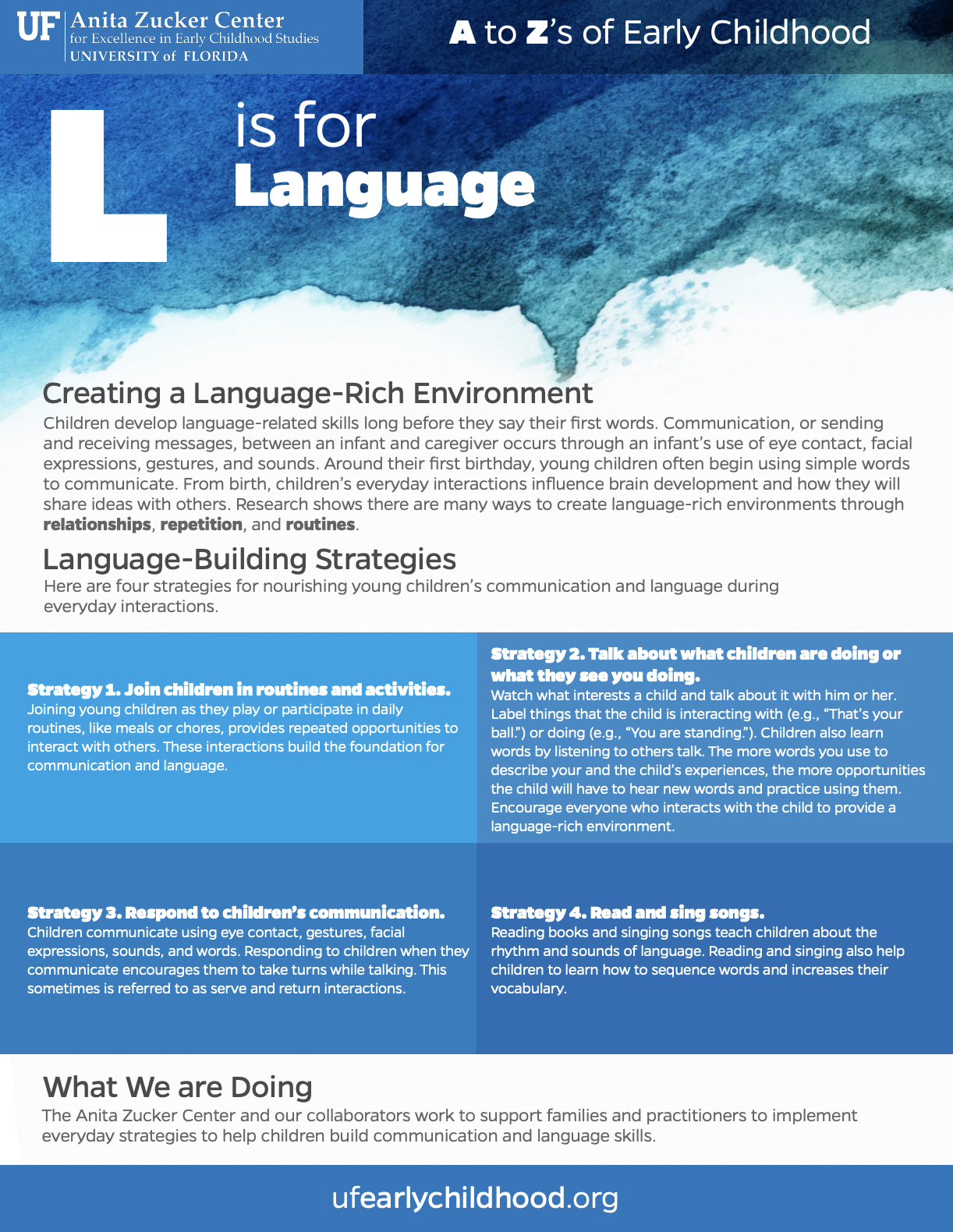A to Z’s of Early Childhood
The Science of Child Development and Learning
L is for Language
Creating a Language-Rich Environment
Children develop language-related skills long before they say their first words. Communication, or sending and receiving messages, between an infant and caregiver occurs through an infant’s use of eye contact, facial expressions, gestures, and sounds. Around their first birthday, young children often begin using simple words to communicate1. From birth, children’s everyday interactions influence brain development and how they will share ideas with others2,3,5. Research shows there are many ways to create language-rich environments through the 3R’s of Early Learning: Relationships, Repetition, Routines ™.

Strategy #1 - Join children in routines and activities.
Joining young children as they play or participate in daily routines, like meals or chores, provides repeated opportunities to interact with others. These interactions build the foundation for communication and language.
Strategy #2 - Talk about what children are doing or what they see you doing.
Watch what interests a child and talk about it with him or her. Label things that the child is interacting with (e.g., “That’s your ball.”) or doing (e.g., “You are standing.”). Children also learn words by listening to others talk. The more words you use to describe your and the child’s experiences, the more opportunities the child will have to hear new words and practice using them. Encourage everyone who interacts with the child to provide a language-rich environment.
Strategy #3 - Respond to children’s communication.
Children communicate using eye contact, gestures, facial expressions, sounds, and words. Responding to children when they communicate encourages them to take turns while talking. This sometimes is referred to as serve and return interactions.
Strategy #4 - Read and sing songs.
Reading books and singing songs teach children about the rhythm and sounds of language. Reading and singing also help children to learn how to sequence words and increases their vocabulary.
Watch these videos to see specific, age-appropriate examples for each language strategy.
0-4 Months
5-8 Months
9-12 Months
13-18 Months
19-24 Months
2-3 Years
4-5 Years
Download these PDFs to see specific, age-appropriate examples for each language strategy
0-4 months (español) | 5-8 months (español) | 9-12 months (español) | 13-18 months (español) | 19-24 months (español) | 2-3 years old (español) | 4-5 years old (español)
What We Are Doing
The Anita Zucker Center and our collaborators work to support families and practitioners to implement everyday strategies to help children build communication and language skills.
Learn More:
- Training Teachers to Teach Vocabulary (T3V): A Professional Development Intervention for Toddler and Preschool Teachers of Children at Risk for Communication Difficulties
This project focuses on providing professional development to Early Head Start and Head Start practitioners to help them support the vocabulary skills of young children at risk for communication delays.
Resources
Communication and Language Milestones
An Introduction to Speech and Language Development
Download this PDF to view a chart of speech and hearing development by age and read tips on encouraging speech and language development.
How Does Your Child Hear and Talk?
Visit this American Speech-Language-Hearing Association (ASHA) website to learn about your child’s speech, language, and hearing development and how you can help with these useful charts organized by age.
Baby Games Calendar
Find activities, milestones, and games based on your infant’s date of birth.
Promoting Communication and Language
CDC’s Developmental Milestones
Download the PDF on this page for examples of language-building strategies for each age range that follow the milestones identified by the CDC for children from birth to 5 years.
At Home With Young Children? Build Preschoolers’ Speech and Language Skills With Everyday Interactions and Activities
Read these 8 tips from the American Speech-Language-Hearing Association (ASHA) on developing preschoolers’ speech and language at home.
Head Start Teaching Practices: Engaging Interactions and Environments
Visit this website to access professional development on language modeling and conversations for children birth to age 5.
Zero to Three: Language and Communication
Watch videos and access resources to learn more about how infants and toddlers develop language.
Early Childhood Technical Assistance Center: Interaction Practice Guides for Practitioners
Read about and watch videos about ways practitioners can have high-quality interactions that support young children’s language development and learning.
Early Childhood Technical Assistance Center: Interaction Practice Guides for Families
Read about and watch videos that provide information about ways families can have high-quality interactions that support young children’s language development and learning within their daily routines.
Reading and Singing
Dialogic Reading: An Effective Way to Read Aloud with Young Children
This article describes how dialogic reading during read alouds offers a more interactive and robust learning experience for young children.
These Are the Type of Books You Should Stock on Your Baby’s Book Shelf
Read this article from ParentCo., based on Anita Zucker Center Affiliate Dr. Lisa Scott’s research, which shows that reading stories with named characters supports brain development.
Language Delays
Early Language and Literacy
This Early Intervention Technical Assistance Portal has videos and resources for professionals and families to support early language and literacy.
What is a Pediatric Speech-Language Pathologist?
Visit this website to learn the types of treatment a pediatric speech-language pathologist can offer.
Dual Language Learners
Háblame Bebé
Download this free app for bilingual parents that includes fun tips for everyday activities and tools to monitor language development in both English and Spanish.
Welcoming and Supporting Dual Language Learners
Use these resources from the National Association for the Education of Young Children (NAEYC) to support young children who are learning a second language while continuing to develop their home language.
Resources for Supporting Dual Language Learners
Access resources to support teachers and administrators in meeting the needs of Dual Language Learners (DLLs) and engaging with their families.
Articles by Center Members and Collaborators
- Lileikyte, R., Irvin, D., & Hansen, J. H. L. (2022). Assessing child communication engagement and statistical speech patterns for American English via speech recognition in naturalistic active learning spaces. Speech Communication, 140, 98-108. https://doi.org/10.1016/j.specom.2022.01.006
- Hindman, A. H., Wasik, B. A., & Bradley, D. E. (2019). How classroom conversations unfold: Exploring teacher–child exchanges during shared book reading. Early Education and Development, 30(4), 478-495. https://doi.org/10.1080/10409289.2018.1556009
- Scott, L. S. (2017, December 14). For baby’s brain to benefit, read the right books at the right time. The Conversation. https://theconversation.com/for-babys-brain-to-benefit-read-the-right-books-at-the-right-time-83076
- Wasik, B. A., & Hindman, A. H. (2018). Why wait? The importance of wait time in developing children’s language and vocabulary skills. The Reading Teacher, 72(3), 369-378. https://doi.org/10.1002/trtr.1730
- Wasik, B. A., Hindman, A. H., & Snell, E. K. (2016). Book reading and vocabulary development: A systematic review. Early Childhood Research Quarterly, 37, 39-57. https://doi.org/10.1016/j.ecresq.2016.04.003
References
- American Speech-Language-Hearing Association. (n.d.). ASHA’s developmental milestones: Birth to 5 years? https://www.asha.org/public/speech/development/chart/
- Hart, B., & Risley, T. R. (1995). Meaningful differences in the everyday experience of young American children. Paul H. Brookes.
- National Research Council, & Institute of Medicine. (2000). From neurons to neighborhoods: The science of early childhood development. National Academy Press. https://doi.org/10.17226/9824
- Zauche, L. H., Mahoney, A. E. D., Thul, T. A., Zauche, M. S., Weldon, A. B., & Stapel-Was, J. L. (2017). The power of language nutrition for children’s brain development, health, and future academic achievement. Journal of Pediatric Health Care, 31(4), 493-503. https://doi.org/10.1016/j.pedhc.2017.01.007
- Wasik, B. A., Hindman, A. H., & Snell, E. K. (2016). Book reading and vocabulary development: A systematic review. Early Childhood Research Quarterly, 37, 39-57. https://doi.org/10.1016/j.ecresq.2016.04.003
Receive Additional Support
The complete 3R’s of Early Learning downloadable video recordings (including the A to Z’s of Early Childhood) for use in the field of childhood development to facilitate learning are available for purchase.
If you would like to purchase these resources or speak with a member of our team for help in providing professional development, please complete this contact form.

